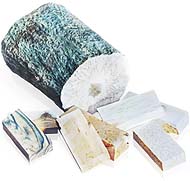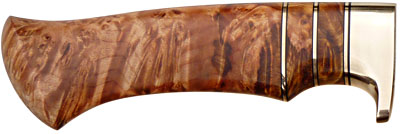 |
MATERIALS Unique products from |
 |
In his products JT uses high quality natural materials that make every product unique. He aims that the materials used for the product are suitable, durable and create an estethically pleasing entity.
JT prefers both well-proven traditional Finnish materials as well as more exotic materials available. |
|
Of Steels and blades |
|
| The blade of the Basic Model Knives is forged from 52100-roller bearing steel. Other blade materials available are the Traditional Damascus Steel or Stainless Damascus Steel. 
With Custom Orders other steels are also available: With knives-sized products VewK-990 & Uddeholm A1 carbon steels and RWL-34, 440-bMo & Aisi-420 stainless steels can be used as blade material. With sword & other large-sized pieces JT uses VeWK-960 & Stenco 0,75C carbon steels and hi-carbon spring steel.
When possible, JT uses recycled steels as blade material.
|
|
|
The carbon content of steels & other ingredients |
|
| The hardenability of steel depends mainly on the amount of carbon in it. Steels best suited to knives usually contain 0,6 - 1,1 % of carbon. For example, the 52100-roller bearing steel has carbon 1,05%, in addition it has 1,3 - 1,6% of chromium and other substances such as manganese, phosphorus and silicon, that improve its properties.
Steels of lower carbon content are usually used when making swords, as impact resistance and durability are the most important properties of a sword blade instead of hardness. When choosing the material for a sword blade, the aspects to be taken into account are the intended use, the cross-section of the blade, its elasticity and when making a re-creation of a historical weapon, the material that has been used in the original blade. For example a medium carbon steel like VewK-960 is closer to the medieval steel in hardness that a hi-alloy carbon steel such as Uddeholm A1 is.
|
|
|
Stainless steels and stainless Damascus steel |
|
| The modern hi-alloyed stainless steels that JT uses excel when used in hunting or field dressing knives. These steel have similar high carbon content as more traditional steels have, but also include 13 -16% chromium that turns the steels to corrosion resistant and improves the grain structure, further enhancing the wear-resistance of the steels. The RWL-34 is a state-of-the-art powder steel, with extra fine grain structure and improved wear resistance.
With Stainless Damascus Steel, two stainless steels have been laminated while in powder form, the steels are RWL-34 (10,5%C) and PMC -27 (0,6%C) When etched with an acid mixture, the PMC-27 is attacked and the damascus steel pattern of the steel becomes visible.
Aisi-420 stainless is a low carbon steel that works best when used in kitchen knives or such blades that are used solely for cutting.
|
|
|
Damascus Steel Forging |
|
| Damascus steel is a combination of two or more different steels. The materials are joined together using 'forge-welding-technique' in which the materials are hammered together while they are in a very high temperature. The materials used often consist of different types of carbon steels, but even non-hardenable iron can be used for the purpose.
Forge-welded Damascus bar is stretched and elongated, then cut in two or three pieces, which are stacked and again forge-welded into one bar. This process is continued until the desired amount of layers has been achieved. The layered Damascus-steel bar can be patterned/manipulated in various ways, by notching, coining or twisting it around its own axis. Usually JT constructs his Damascus steel blades from several laminated bars that he forge-welds together to create a blank for a blade.
Sword blades made according to historical originals usually are constructed from several pre-patterned Damascus steel bars, they are commonly known as 'pattern-welded' blades.
|
|
|
Materials for handles and their qualities |
|
| For handles, JT uses mostly natural materials. What material used for a knife handle depends on the intended use of the knife and what is the structure of the hilt. Traditional materials such as curley birch, root burl and ebony can be used either with through-tang or hidden tang constructions. Such materials as birch bark or leather require a through-tang structure with a riveted bolster at the end. For bolsters, JT prefers brass or bronze as a material. 
Handles made of antler are usually one-of-a-kind pieces, with a particular piece of antler chosen for the purpose. A moose horn can be a very handsome material for a handle, but the shape of the handle is determined by the horn as the hard and durable surface can be only few millimeters thick. Antler serves well as a material for carved decoration work. More exotic materials such as walrus ivory, buffalo horn and mammoth ivory JT uses mostly on one-of-a-kind custom works. Walrus ivory is the preferred material for carved work. JT uses mainly antique walrus ivory that is thousands of years old. Such hardwoods as cocobolo, bubinga, ebony, desert ironwood, pink ivory and thuya JT uses upon request on the hilts of custom works or one-of-a-kind pieces. Often several materials are used in one handle, for example, curley birch, antler and birch bark - this way the handle turns out looking handsome and durable in use. Traditionally constructed birch bark handle is very durable, warm and 'non-slipping' - a very safe handle to use. A handle made of stacked leather has very similar qualities, so it is well suited for a for a hunting knife hand.
On some products JT prefers modern materials, for example in kitchen knives JT uses synthetical materials such as POM-plastic, Elforyn or Tru Ivory ivory-imitations.
|
|
|
The sheath is the finishing touch of a knife |
|
| The knife must have a sheath that is both safe and practical. It must be such that the knife can be carried along without having to worry about losing the knife. This is why JT stitches every sheath by hand straight over the knife and carves the wooden liner to each blade separately. This way the sheath turns to be a second skin to the knife and there is a distinct "snap" when the knife goes home into the sheath. 
The shaping and decorating of each sheath is done to each sheath separately when the leather is still moist and pliable. The ready sheath is hand dyed and the belt loop is joined to the sheath with a stainless steel hanger. The surface of the leather is impregnated with grease to protect it against water. The leather used in sheaths is vegetable tanned leather that keeps its form very well when dry. JT also uses so-called 'half-tanned leather' which works well with "pauting-technique", a method of making very three-dimensional and detailed decorations on leather. Sheaths made of 'half-tanned' leather are very hard and durable in use. Most of the sheaths JT makes are of the traditional 'back-seamed' type, but depending on the design & the size of the knife he makes also side-stitched types as well. Scabbards for swords JT usually constructs from double-layered leather.
|
|
| | |

